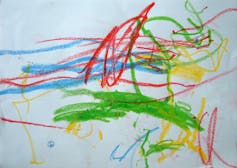How To Draw A Child Realestic
Drawing plays a big role in our cognitive development. Information technology tin can assistance united states learn to write and think creatively, develop hand-heart co-ordination, hone analytic skills, and conceptualise ideas.
But cartoon is rarely used as a tool for learning in schools. Generally, most loftier school teachers aren't trained in visual educational activity.
Drawing is non something that should be confined to fine art lessons – it's a skill that tin play a role in many different subject areas in school education, and later on in the workplace.
For loftier school students, drawing can be incorporated into learning in many ways, including visual mapping, reflective thinking, organising and presenting data, and a way of communication that can transcend language barriers.
Just the transition from master to high school oftentimes brings out insecurities in one's drawing power. This means students can exist reluctant to use drawing every bit a way of organising their thoughts .
Here's why drawing is and then important, and why kids should be taught the skill in school.
How children larn to draw
Drawings are external representations of your thinking – and when you were fiddling you were doing this all the time.
When people say they can't describe, what they actually hateful is they can't draw something exactly as it looks. But, like any skill, cartoon must be trained.
It is widely believed that in that location are six stages to drawing. These include:

Scribbling stage (two-4 years):
Children go through a process of understanding that their physical deportment tin can dictate the marks they make. Initially this is random scribble (kineasthetic action), but develops to a more controlled activeness.
Pre-schematic stage (four-seven years):
Children brainstorm to use shapes and symbols to explore relationships and their surroundings.

Schematic phase (seven-9 years):
Children develop a "schema", or consistent way of portraying an object or person or surround. These images generally exhibit their noesis of something.
Realistic phase (nine-12 years):
Children begin to focus on detail and realistic features in their drawings. They are conscious of their peers and the level of item in their drawings.

Pseudo-naturalistic stage (12-14 years):
Children begin to focus on the final product, on whether the image looks practiced and is pleasing to peers and parents. They brainstorm to have an understanding of three-dimensional space in their drawings. Students tin can often be displeased with the outcome.

Crisis of adolescence/ artistic conclusion (xiv-17 years):
In the boyish phase, a conscious conclusion must be made to keep drawing and engaging in visual thinking. Images created become highly individualised.
How drawing can aid you retrieve creatively
Drawing is used in many fields like medicine to teach observation skills in diagnosis, in anthropology as a method of taking field notes, in science to document experiments and processes, in design to conceptualise ideas, in architecture to map out and spatialise buildings, and in applied science to develop prototypes.
Francis Wells, a cardiothoracic surgeon, does drawings in guild to map out his surgery process, even to the extent of drawing with patient blood during the surgery (as seen below).
Sketching is the perfect tool for brainstorming and rapid idea generation or quickly recording field notes.
Visual mapping is a way of identifying problems and creating links. Information technology doesn't require y'all to describe something exactly every bit it is.
Learning simple visual system techniques similar synectics, a connective thinking technique, gestalt theory, the psychology of meaningful perception, the dominion of thirds as a technique of composition, colour psychology, how we use colour to engage a viewer, and the principles of design tin aid students organise and engage data across the curriculum.
The University of Newcastle has a long-established Natural History illustration program that has seen the collaboration between science and analogy to visualise phenomena in the natural world. Students use drawing and illustration to communicate findings in fields like medicine, taxonomy and archaeology.

Drawing and innovation
A company in Sydney, Meld Studios, almost purely focuses on service design, and has recently redesigned the State Library of Victoria'southward services.
They use drawings to help examine the way people interact with the library in gild to run into new generational needs. They visually map drawings and notes about the different interactions people have with the library on a large forensic wall to better outline systems of service and user experience.
There arises a growing need for our education organization to produce innovative and creative members of Australian society – students need to be creative thinkers.
The fundamental way they tin can exist creative is past learning to translate thoughts and ideas into real and tangible things.
Source: https://theconversation.com/why-is-teaching-kids-to-draw-not-a-more-important-part-of-the-curriculum-60379
Posted by: cintroninted1943.blogspot.com


0 Response to "How To Draw A Child Realestic"
Post a Comment